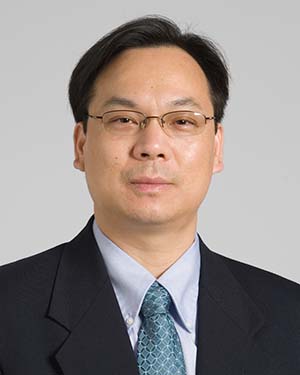Research News
06/30/2021
Researchers Find New Cancer Stem Cell-Related Target for Treating Glioblastoma
Dr. Bao’s group found that inhibiting DNA-PK overturns the pro-cancer properties of glioma stem cells and suppresses tumor growth in preclinical models, suggesting DNA-PK as a potential therapeutic target for treating glioblastoma.

Researchers led by Shideng Bao, PhD, have defined a new mechanism that contributes to the lethality of glioblastoma. The findings, published in Science Translational Medicine, focus on a particularly dangerous subset of cancer cells called glioma stem cells, which can self-renew and promote tumor growth and resistance to conventional therapies.
Previous research has shown that a protein called SOX2 plays an important role in maintaining the disease-driving properties of glioma stem cells. In this new study, Dr. Bao's team and his collaborators discovered that another component called DNA-PK (DNA-dependent protein kinase) is also involved. According to their findings, DNA-PK critically controls the stability of SOX2 to maintain glioma stem cells in glioblastoma.
"Our preclinical findings indicate that DNA-PK is a promising new target for disrupting the pro-tumor properties of glioma stem cells to improve glioblastoma treatment," said Dr. Bao, who is research staff in the Department of Cancer Biology and director of the Center for Cancer Stem Cell Research.
How DNA-PK maintains glioma stem cells to drive glioblastoma growth
The researchers found that DNA-PK actually modifies the SOX2 protein through a process called phosphorylation, which stabilizes and prevents SOX2 degradation. It is this stable form of SOX2 that helps maintain the self-renewing and pro-tumor characteristics of glioma stem cells.
As Dr. Bao explains, one of the defining characteristics of glioma stem cells is their resemblance to neural stem cells. Similar to neural stem cells, glioma stem cells are poorly differentiated or completely undifferentiated, meaning they have the capacity to self-replicate and to differentiate into a variety of specialized brain cells.
"These characteristics, plus their ability to invade normal brain tissue, make glioma stem cells major drivers of disease progression and therapeutic resistance," said Dr. Bao. "Therefore, eliminating them or inducing their differentiation may improve therapeutic efficacy for glioblastoma."
Interestingly, the team found that targeting DNA-PK promotes glioma stem cell differentiation, leading to the inhibition of tumor growth and increased sensitivity to radiotherapy in preclinical models.
Accelerating differentiation holds promise to slow disease
Radiation and chemotherapy drug such as etoposide or temozolomide work by damaging DNA in cancer cells. Dr. Bao's team found that this DNA damage caused the DNA-PK/SOX2 protein complex to separate. As a result, the SOX2 protein degraded, helping to accelerate glioma stem cell differentiation. In other models, the researchers inhibited DNA-PK activity by its specific inhibitor or disrupted DNA-PK expression, which directly resulted in SOX2 degradation and glioma stem cell differentiation.
"We found that pharmacologically inhibiting DNA-PK potently promoted glioma stem cell differentiation, thereby preventing or reducing their capacity to self-replicate and suppressing glioma stem cell-driven tumor growth. Because glioma stem cells are much more resistant to radiation than differentiated glioma cells, targeting DNA-PK to induce glioma stem cell differentiation sensitized glioblastoma to radiation in preclinical models and improved the therapeutic efficacy," said Dr. Bao.
Given the beneficial effects in animal models, the researchers believe that targeting DNA-PK alone or in combination with other therapies, such as radiation, for treating glioblastoma is worthy of future investigation in clinical trials.
Xiaoguang Fang, a postdoctoral fellow in Dr. Bao's lab, is first author on the study. Dr. Bao's lab is investigating several cancer stem cell-related targets for treating glioblastoma, also including the proteins WISP1 and BMX. His collaborators from Lerner Research Institute include Drs. George Stark, Alexandru Almasan, Jennifer Yu and Xiaoxia Li. This work was supported in part by the National Cancer Institute and the National Institute of Neurological Disorders and Stroke (both parts of the National Institutes of Health).
Featured Experts
News Category
Related News
Research areas
Want To Support Ground-Breaking Research at Cleveland Clinic?
Discover how you can help Cleveland Clinic save lives and continue to lead the transformation of healthcare.
Give to Cleveland Clinic